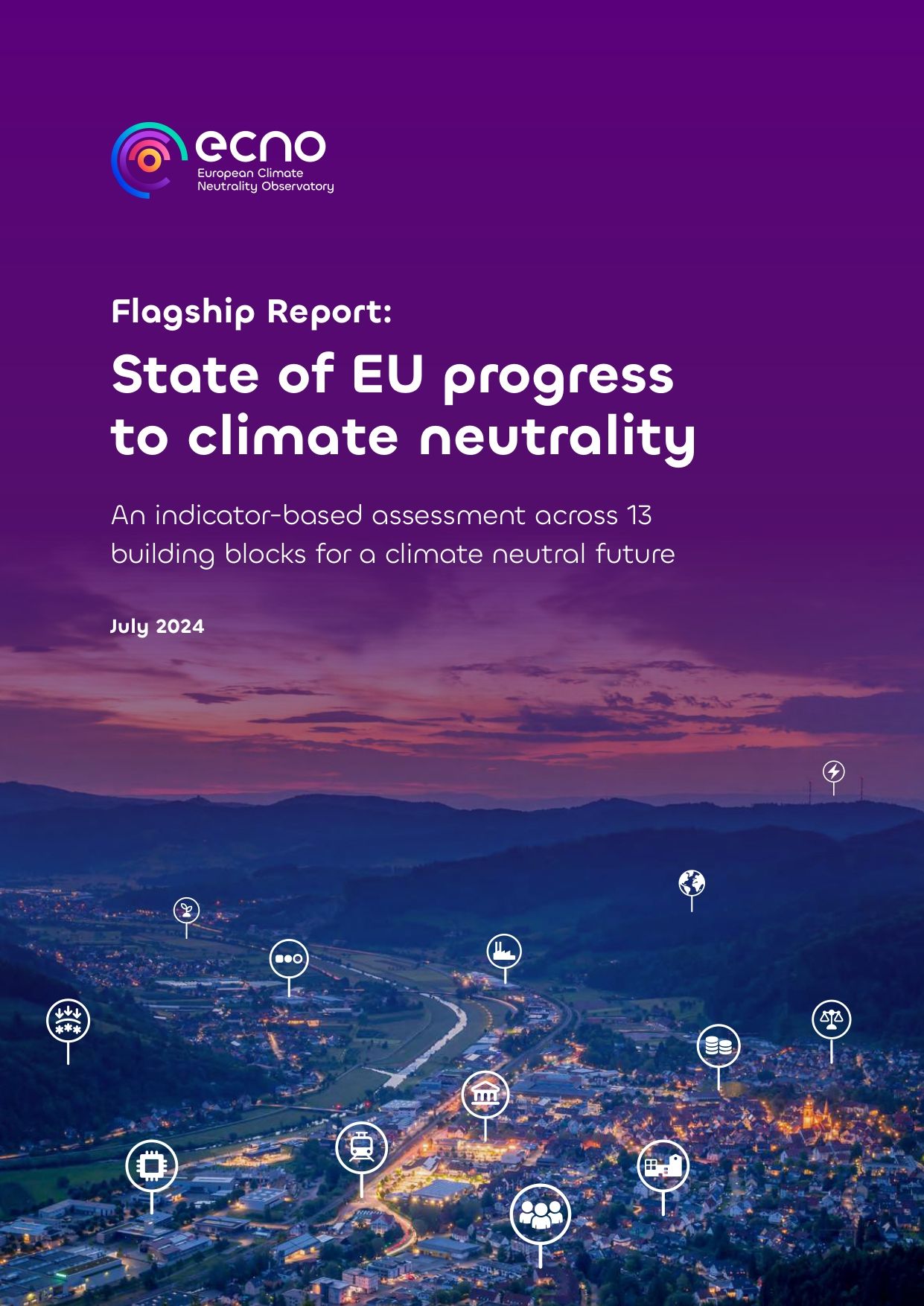State of EU progress to climate neutrality
Assessing the state of progress to inform next steps in policy-making
The European Union (EU) is on its journey to become climate neutral by 2050. This multigenerational project holds many societal, economic, and environmental opportunities. At the same time, it is of unprecedented scale and implies considerable changes to the current systems, which need to be anticipated and addressed for the transition to be fair and acceptable to all. Regular progress checking is the key to understanding where the EU stands on the journey. It allows to identify challenges and opportunities and take targeted policy action guiding investment, supply, consumption, and societal development. There is still no official, comprehensive, and regular EU-wide progress monitoring to achieve this.
This second ECNO progress check aims to close the current information gap. It provides a comprehensive view on the state of EU progress towards climate neutrality and identifies key areas of action for the next policy cycle.
The state of progress: notable advancements but still too slow
The EU has kept up its progress towards climate neutrality in many building blocks for a climate neutral society. Even though all 13 building blocks remain in the same progress classification as in the 2023 assessment, still requiring the transition to pick up pace, a closer look reveals important and promising progress in individual indicators and in new and revised policies. In this year’s assessment, 75 indicators are moving in the right direction, and many small-scale shifts are bubbling under the surface. Ten indicators improved in their classification while three slowed down in their progress, changing to a lower classification:
Industrial GHG emissions decreased at a higher speed. This was also seen in agriculture. However, the pace of GHG reductions slowed in electricity generation. The deployment of renewables and clean energy carriers picked up speed. Industrial energy intensity also improved as did public funds for environmental and energy R&D.
The transition to climate neutrality generated more jobs in renewable energy supply chains and in environmental goods and services. Regional poverty in coal and heavy industry regions declined, positively supported by an overall improvement in employment there.
However, the progress on reducing material deprivation slowed down due to the spike in fossil energy prices. There was an increase in public support for households, but it was disproportionately focused on short-term relief rather than long-term resilience. Fossil fuel subsidies tripled between 2021 and 2022, outpacing the growth in support for energy efficiency purposes, the share of which thus decreased.
Finally, there was an increase in the EU’s official development assistance (ODA) allocated to climate action in 2021. This is an improvement, but the proportion of ODA allocated to climate action is still far too low.
Click here to see “Figure 1 State of progress across 13 building blocks of a climate neutral future”
Actions for 2024-2029 EU policy
1: Advance effective implementation of the existing policies
The broad set of EU policies adopted in the past four years now requires national implementation, thus it is identified as an action area in each building block. EU-level support to Member States, along with further specification of the legal requirements and stricter follow-up to ensure adherence would facilitate national implementation.
2: Get the finance right for the transition
A strong policy push is needed to redirect financial flows towards transition financing, including progressively phasing out fossil fuel subsidies, and to close the investment gap. Progress could be made by developing a new EU financing plan integrating existing regulations and funds to facilitate coordination and support for Member States.
3: Ensure a socially just and people-centred transition
Citizens show strong support for climate action. To maintain citizens’ resolve, further progress is needed to ensure that they feel engaged in the process and that no one is left behind. A citizen-centric approach to decisions over the coming years could strengthen this dimension.
4: Accelerate the industrial transition as part of an EU competitiveness deal
Providing additional EU-level funding and leveraging existing spending may accelerate progress of the industrial transition. In addition, national energy and climate plans (NECPs) should consider the three enablers – circularity, energy efficiency, and zero carbon energy carriers.
5: Encourage efficiency, modal shift,and electrification in buildings and mobility
For buildings, the achievement of wide-spread deep renovation could be helped through compliance support and an enforcement system. In mobility, progress could be made by targeting corporate fleets, expanding cross-border public transport, and supporting Member States in their incentive schemes and infrastructure development.
6: Ensure a predictable and just transition in agriculture
Advancing progress in agrifood can build on a shift of public funding to encourage low-emission, socially just and resilient agriculture. Standardised criteria for food procurement and labelling would support healthier, plant-based diets. Action should be taken to reduce food waste.
7: Invest in (natural) carbon dioxide removals urgently
There is an urgent need to further expand sustainable forest practices and promote restoration, reforestation, and sustainable management – including a shift towards more near-natural forests. Deployment of technical CDR requires demonstrating its sustainability.
8: Enhance global climate action through climate finance and diplomacy
Global climate action could be advanced by the EU through effective partnerships and a foreign and trade policy centred around the global transition. International climate finance should correspond to the fair share and alignment of all public funds with the goals of the Paris Agreement.
9: Improve data for smarter policy-making
Action should be taken to close data gaps. These can include new or better reporting obligations and adjusted data collection routines that also improve the efficiency of processes and spending.
10: Establish an official EU-wide transition monitoring
The need for an official EU progress monitoring system persists. Integrating smartly with existing planning, monitoring, and reporting activities, such a system would allow for greater comparability, facilitate evaluations, and increase transparency. It could reduce overall effort and administrative burden for Member States and EU institutions alike.
The European Climate Neutrality Observatory is an independent, consortium-based entity, initiated and supported by the European Climate Foundation.



